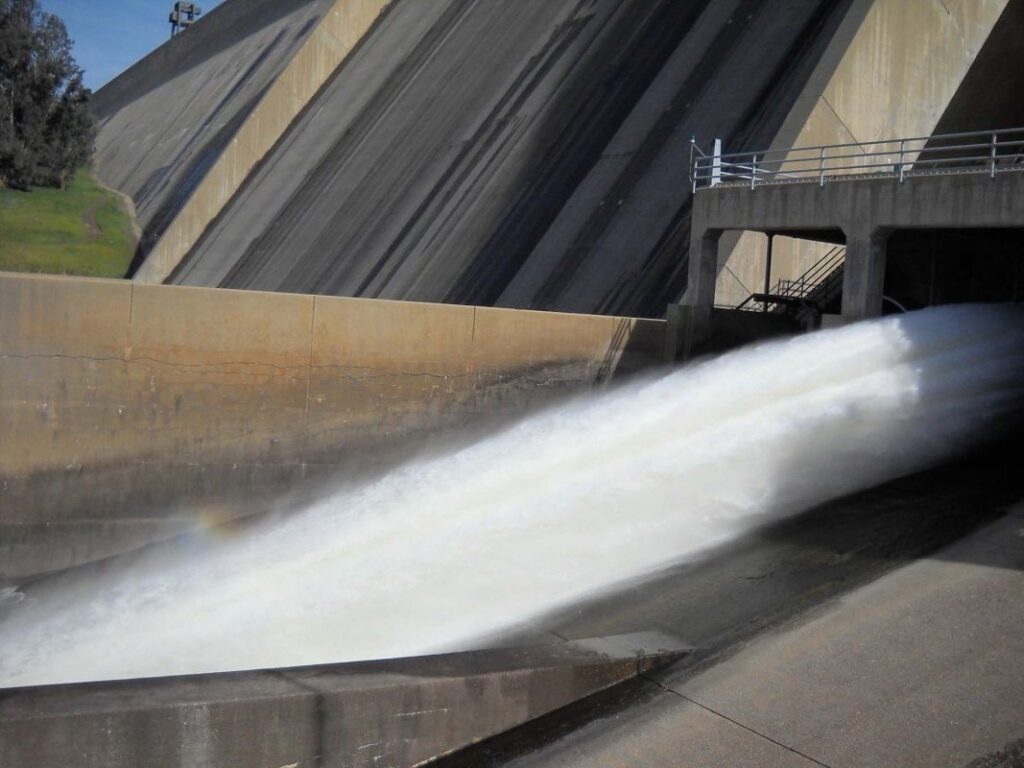
Program to release first ever summer pulse flow for salmon spawning
Starting early morning, Tuesday, September 10, the San Joaquin River Restoration Program (Program) will release a scheduled pulse flow on the San Joaquin River. Friant Dam releases will increase from 450 cubic-feet-per-second (cfs) to 1500 cfs for several hours, then decrease to 1000 cfs overnight and return to normal Friant Dam releases on Wednesday, September 11. The pulse is designed to clear Chinook salmon spawning beds of sand and algae, improving salmon reproduction this autumn and is the first summer pulse ever conducted by the Program.
The public is cautioned that the San Joaquin River will rise nearly 2 feet near Friant Dam. As the pulse flow moves downstream, it will gradually diminish but will still result in stronger currents, deeper water, and colder water temperatures. The public is encouraged to check Friant Dam releases before recreating near the San Joaquin River as conditions may change from day to day and can do so on-line at: https://cdec.water.ca.gov/dynamicapp/QueryF?s=SJF
Pulse Flow Forecast:
| Date | Friant Dam Releases | Conditions at Lost Lake County Park | Conditions at Camp Pashayan near Hwy 99 | Conditions at Skaggs Bridge Park near Hwy 145 |
| Tuesday, September 10 | Releases increasing to 1500 cfs starting at 4 AM, then decreasing to 1000 cfs at 8 PM | River will rise rapidly by 2 feet, with flows increasing from 400 cfs to 1400 cfs by noon | 300 cfs through day, increasing flows overnight | 250 cfs |
| Wednesday, September 11 | Releases decreasing to 750 cfs at 8 AM and 410 cfs at noon | River will fall throughout day, from 900 cfs in morning to 500 cfs in afternoon | River will rise by 1 foot, with flows increasing to 600 cfs by morning and gradually decreasing overnight | 250 cfs |
| Thursday, September 12 | 400 – 450 cfs | River will gradually decrease to 400 cfs | Decreasing flows throughout the day to 400 cfs | River will rise by 1 foot, with flows increasing from 250 cfs to 500 cfs by morning |
| Friday, September 13 | 400 – 450 cfs | 400 cfs | Decreasing flows throughout the day to 300 cfs | Decreasing flows throughout the day to 400 cfs |
| Saturday, September 14 | 400 – 450 cfs | 400 cfs | 300 cfs | Decreasing flows throughout the day to 300 cfs |
The pulse flows are part of the updated Restoration Flow schedule approved by the Bureau of Reclamation for the 2024 water year. The 2024 Restoration Allocation provides a total 329,026 acre-feet for Restoration Flows under a Normal-Wet water year type.
Following this September pulse flow, releases from Friant Dam will remain at 380 – 450 cfs through the autumn. Salmon are expected to spawn from mid-September through November and the eggs will incubate in the gravel until the young salmon fry emerge from November through January.
The Restoration Flow schedule has been set to the following:
| Date | Friant Dam Releases | Flows Rate at Gravelly Ford |
| September 1 – 9 | 450 cfs | 200 cfs |
| September 10 – 14 | See detailed table above | Increasing to 450 cfs then decreasing |
| September 15 – October 31 | 380 – 450 cfs as required to meet the flow target at Gravelly Ford | 200 – 205 cfs |
| November 1 – December 31 | 380 – 450 cfs as required to meet the flow target at Gravelly Ford | 235 cfs |
| January 1 – February 28, 2025 | 380 – 450 cfs as required to meet the flow target at Gravelly Ford | 255 cfs |
For Information about Restoration Flows, please visit http://sjrrpstg.wpenginepowered.com/restoration-goal/restoration-flows/.
For the Restoration Administrator recommendations, please visit http://sjrrpstg.wpenginepowered.com/documentsreports/ra-recommendations/
For additional information about the San Joaquin River Restoration Program, please visit http://sjrrpstg.wpenginepowered.com or contact Josh Newcom, Public Affairs Specialist, at 916-978-5508 or snewcom@usbr.gov.
